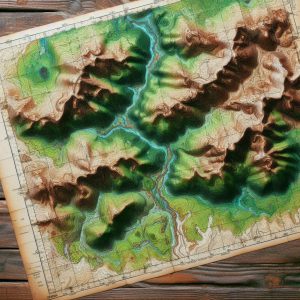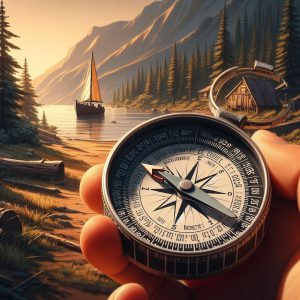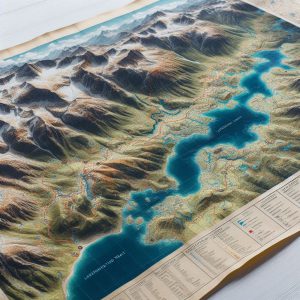Enhance Your Wilderness Navigation Skills: A Comprehensive Guide for Outdoor Enthusiasts Without GPS
Gaining proficiency in wilderness navigation without relying on modern technology may initially seem overwhelming. However, developing essential map and compass navigation skills is a critical capability that can significantly enrich your outdoor adventures. At its essence, effective navigation requires a thorough comprehension of your surroundings and the ability to determine your current position in relation to your target destination. A map serves as a precise two-dimensional visual guide of the terrain, while a compass is an indispensable tool for orienting yourself using the cardinal points: north, south, east, and west. By mastering these key tools, you can explore the wilderness confidently, independently of technological devices.
Begin your navigation journey by immersing yourself in the various symbols and scales featured on a map; these elements are essential for accurately interpreting the physical landscape. Learning to read contour lines, which depict elevation variations, is crucial as it enables you to identify prominent hills, deep valleys, and other geographical landmarks that may affect your chosen route. Furthermore, becoming adept at using a compass is equally vital, granting you the capability to navigate effectively through the wilderness without dependence on GPS technology.
The compass needle consistently aligns with magnetic north, allowing you to orient your map with the actual landscape. To achieve this, hold the compass flat in your hand and rotate the map until the magnetic north on the compass aligns with the north indicated on the map. This crucial technique, referred to as “orienting the map,” is essential for maintaining precision in your navigation efforts, helping ensure that you remain on course as you venture through the wilderness.
Once your map is accurately oriented, you can use the compass to establish bearings that will direct your journey. By effectively integrating these two powerful navigational instruments—the map and the compass—you will confidently navigate through unfamiliar terrains, ensuring that you stay on course even without the aid of contemporary technological tools.
Essential Strategies for Successful Outdoor Navigation
- Mastering map and compass navigation is a fundamental skill for anyone interested in wilderness exploration or engaging in outdoor activities.
- Topographic maps provide detailed insights into the landscape, elevation changes, and natural features, which are critical for effective navigation.
- A compass not only helps establish direction but also plays a significant role in navigation by aligning with the map’s orientation and understanding magnetic north.
- Natural landmarks and cues, such as unique rock formations or recognizable tree patterns, can serve as invaluable navigational aids when a map or compass is not at hand.
- Estimating distance and travel time is important for planning and executing a successful navigation strategy while exploring the wilderness.
 Recognizing the Value of Topographic Maps for Effective Wilderness Navigation
Recognizing the Value of Topographic Maps for Effective Wilderness Navigation
Topographic maps are indispensable tools for anyone planning to venture into nature’s raw beauty. They contain extensive information about the physical characteristics of the landscape, utilizing contour lines to illustrate elevation changes. This capability allows you to visualize the terrain’s shape and steepness, making it easier to prepare for potential challenges that lie ahead. Each contour line connects points of equal elevation, and the spacing between these lines reveals whether the slope is steep or gradual, equipping you with crucial knowledge for effective navigation.
Decoding Contour Lines and Map Symbols for Better Navigation
As you dive into a topographic map, it’s essential to scrutinize the patterns created by contour lines; closely spaced lines indicate steep terrain, while more widely spaced lines represent flatter areas. This knowledge will empower you to foresee possible challenges along your journey, enabling you to make informed navigational choices. Additionally, topographic maps are rich with symbols representing various landmarks, including rivers, roads, trails, and types of vegetation. Familiarizing yourself with these symbols is vital for successful navigation, ensuring that you can effectively utilize the map.
Implementing Navigation Techniques with Topographic Maps
For example, blue lines typically denote the presence of water bodies, such as lakes or streams, while green areas may signify forests or dense foliage. By cross-referencing these symbols with your surroundings, you can confirm your position and modify your route as necessary. Moreover, topographic maps often contain grid lines that assist in identifying coordinates, allowing for even more precise navigation. By mastering the nuances of topographic maps, you will deepen your connection to the landscape and enhance your overall navigational prowess in the wild.
 Harnessing Directional Navigation Techniques Using a Compass
Harnessing Directional Navigation Techniques Using a Compass
A compass is an essential tool for any outdoor adventurer, providing invaluable support for directional navigation, especially when traversing unfamiliar terrain. To utilize a compass effectively, start by holding it level in front of you and allow the needle to stabilize. The needle will point toward magnetic north, which can vary slightly from true north due to magnetic declination—the angle between magnetic north and true north changes based on your geographical location.
Before setting off on your adventure, it is crucial to determine the local declination and adjust your compass accordingly. This adjustment ensures that your bearings remain accurate, allowing you to maintain your intended course throughout your journey. Once your compass is calibrated for declination, you can proceed to take a bearing that will guide your direction of travel.
To take a bearing, identify a landmark you wish to reach and rotate the compass housing until the orienting arrow aligns with the magnetic needle. The degree reading on the compass dial that aligns with the index line indicates your bearing. As you advance toward your destination, periodically check your bearing to confirm that you remain on track.
If you find yourself drifting off course, simply reorient your compass and adjust your trajectory as needed. By mastering these techniques, you will gain the confidence to rely on a compass as a trustworthy navigational aid during any outdoor excursion.
 Utilizing Natural Landmarks and Signals for Effective Navigation
Utilizing Natural Landmarks and Signals for Effective Navigation
While maps and compasses are vital navigational tools, keen observation of natural landmarks and signs can significantly enhance your ability to navigate through the wilderness effectively. Distinctive features such as mountains, rivers, or unique trees can serve as essential reference points when navigating unfamiliar terrain. For instance, if you know a specific mountain is located to the east of your starting point, you can use it as a directional guide to ensure you’re traveling in the correct direction.
Moreover, familiarizing yourself with the unique characteristics of your surroundings will aid in constructing mental maps that enable you to navigate without relying solely on tools. In addition to prominent geographical markers, be attentive to natural indicators that may signal direction or changes in the landscape. The sun’s position can provide useful guidance; in the northern hemisphere, the sun rises in the east and sets in the west, offering a general sense of orientation throughout the day.
Furthermore, observing the growth pattern of moss on trees—often denser on the north side—can yield valuable clues about orientation in dense forests. Animal trails can also serve as directional indicators; many animals follow established paths that may lead you toward water sources or other significant landmarks. By honing your ability to interpret these natural cues, you will become increasingly adept at navigating various environments.
Estimating Distance and Travel Time for Effective Wilderness Navigation
Estimating distance and travel time is fundamental for efficient navigation in wilderness areas. Understanding how far you have traveled and the time required to reach your destination allows for informed planning and the avoidance of unexpected obstacles. One effective technique for estimating distance is pacing—counting your steps as you walk.
On average, an adult’s stride measures approximately 2.5 feet, which means that by counting your steps over a known distance, you can estimate how far you have traveled based on your pace. Additionally, it’s important to consider the terrain type and elevation changes when calculating travel time. For example, moving across flat ground typically allows for faster travel compared to navigating steep hills or rocky paths.
A common guideline suggests that you can cover roughly three miles per hour on flat terrain; however, this estimate should be adjusted significantly when faced with challenging landscapes. By taking these factors into consideration and adapting your expectations accordingly, you will be better prepared for your adventure and more capable of managing your time effectively.
Creating a Strategic Wilderness Navigation and Route Plan
Designing Your Wilderness Route for Optimal Success
Formulating an effective navigation plan is vital before embarking on any wilderness expedition. Begin by examining topographic maps of the region you intend to explore, identifying potential routes based on prominent landmarks, existing trails, and accessible water sources. As you develop your route, consider factors such as elevation changes and the difficulty level of the terrain; ensuring your plan is both realistic and achievable is essential.
Preparing for Unexpected Obstacles and Environmental Changes
While planning your route, it’s prudent to contemplate alternative paths in case you encounter unforeseen obstacles or sudden shifts in weather conditions. Having multiple options will provide you with greater flexibility during your journey and contribute to your overall safety. This adaptability is crucial for a successful and enjoyable wilderness experience, allowing you to navigate any challenges that may arise with assurance.
Creating a Detailed Navigation Strategy for Clarity
After mapping out possible routes, develop a comprehensive navigation plan that includes critical waypoints. Mark these waypoints on your map and, if possible, note their coordinates, which will enable you to track your progress as you navigate through the wilderness. Additionally, consider estimating travel time between waypoints and identifying potential hazards you might encounter along your chosen route.
Ensuring Your Outdoor Experience is Safe, Enjoyable, and Rewarding
Thorough planning and anticipating challenges will enhance your likelihood of reaching your destination while enjoying a safe and fulfilling outdoor experience. A well-structured navigation strategy is essential for a successful wilderness adventure, ensuring that you can explore the great outdoors with confidence and security.
 Applying Emergency Navigation Techniques for Unforeseen Situations
Applying Emergency Navigation Techniques for Unforeseen Situations
Despite thorough planning and preparation, unexpected circumstances may arise during outdoor excursions that require emergency navigation techniques. One critical skill is the ability to backtrack; if you become lost or disoriented, retracing your steps can often lead you back to familiar ground. To execute this technique effectively, pay close attention to distinctive landmarks or features encountered along your route, as they can serve as essential reference points when returning.
Another invaluable technique is celestial navigation, particularly useful when visibility permits—especially during clear nights or sunny days when stars or celestial bodies are observable. Familiarizing yourself with prominent constellations, like the North Star (Polaris) in the northern hemisphere, can guide you, as it remains relatively fixed in position while other stars move. By locating Polaris and determining its angle relative to the horizon, you can identify true north, even without a compass or map.
If you carry a watch or smartphone as a backup, utilizing it alongside celestial navigation can bolster your sense of direction during emergencies, helping you maintain orientation even in challenging situations.
Advancing Your Wilderness Navigation Skills: Practical Strategies for Improvement
Enhancing your wilderness navigation skills requires dedication and consistent practice, but the benefits can significantly elevate your outdoor experiences. One effective method is to join local hiking groups or outdoor clubs, where members can share their knowledge and experiences regarding navigation techniques. Interacting with experienced navigators can provide valuable insights into best practices while offering hands-on learning opportunities across various terrains.
Another advantageous approach involves regularly practicing with maps and compasses in a variety of settings—whether in urban environments or remote wilderness areas—to build your confidence in these essential skills. Allocate time for solo excursions where you intentionally navigate without technological aids; this practice will reinforce your abilities while fostering a deeper connection with nature. Additionally, consider maintaining a navigation journal to document routes taken, challenges faced, and lessons learned during each adventure; this reflective practice will not only sharpen your skills but also deepen your appreciation for navigating diverse landscapes.
By embracing these techniques and continually refining your skills in map reading, compass usage, natural observation, distance estimation, route planning, emergency strategies, and sharing practical experiences with others, you will evolve into a more self-assured navigator, capable of thriving in any wilderness environment, even without the support of technology.
Your Inquiries Addressed: FAQs About Wilderness Navigation
What constitutes wilderness navigation?
Wilderness navigation encompasses the essential skills required to determine and maintain a route through natural, often remote, and undeveloped regions. It involves the use of various tools and techniques to stay oriented and safely reach a designated destination.
What traditional methods are employed in wilderness navigation?
Traditional wilderness navigation methods include utilizing a map and compass, interpreting topographic features, observing natural landmarks, and employing celestial navigation techniques based on the movements of the sun, moon, and stars.
Why might someone choose to navigate without GPS?
Many individuals opt to navigate without GPS for various reasons, including the desire to enhance their wilderness navigation skills, embrace the challenge of traditional methods, or prepare for potential GPS failures or limited access to technology.
What advantages come with learning wilderness navigation without relying on GPS?
Learning wilderness navigation techniques without GPS can deepen an individual’s understanding of the natural environment, foster self-reliance and confidence, and provide a contingency plan in case of technology failures or limited access to GPS devices.
What challenges may arise when navigating in the wilderness without GPS?
Challenges associated with wilderness navigation without GPS include the necessity for advanced planning, the potential for human error, and reliance on environmental conditions such as weather and visibility.
The post Wilderness Navigation Techniques Without GPS appeared first on Survival Bite.
The Article Wilderness Navigation Techniques for Off-Grid Adventures Was Found On https://limitsofstrategy.com



Your exploration of wilderness navigation without reliance on GPS resonates deeply with those of us who value both the adventure and the skills necessary to enjoy our natural surroundings fully. In an era where technology often dictates our routes, the art of reading a map and using a compass can seem nearly archaic, yet it is more relevant than ever.
It’s refreshing to see someone appreciate the deeper layers of wilderness navigation. The skills of using a map and a compass truly offer a different connection to nature. When you rely on these tools, there’s a sense of empowerment that comes from understanding the landscape around you—it’s about developing an intuition for the terrain that technology just doesn’t provide.
I completely resonate with your perspective on wilderness navigation. There’s something profoundly grounding about using a map and compass; it’s almost meditative. The connection to nature becomes more tangible when you’re engaged in the physical act of interpreting the land instead of just following a screen.
It’s interesting how connecting with nature through navigation parallels the way we harness energy in candle magic—both practices invite us to engage with our surroundings on a deeper level, fostering a unique understanding of the world.
‘Candle Magic Power: Harnessing Energy Through Flames’
https://blogpeeper.com/candle-magic-power-harnessing-energy-through-flames/.
I can really relate to what you said about wilderness navigation feeling meditative. There’s something about stepping away from the digital noise and embracing the tactile experience of a map and compass. It’s almost as if the act of physically interpreting the landscape helps to ground us, providing a sense of presence that’s often lost in our screen-driven world.
I completely resonate with that feeling of becoming more in tune with ourselves and the environment when we navigate using just a map and compass. There’s a certain rhythm to it, isn’t there? Just the act of unfolding a paper map and tracing a route with your finger can feel like a mini ritual. It forces us to slow down, to really observe our surroundings rather than simply passing through them with our heads down, absorbed in a screen.
I can’t help but think that mastering craftsmanship techniques, like those with apron fronts and split toe seams, offers a similar kind of grounding experience, inviting us to connect with our hands and the materials in a way that digital tools simply can’t replicate.
‘Apron Front and Split Toe Seams: Mastering Craftsmanship Techniques’
https://blogpeeper.com/apron-front-and-split-toe-seams-mastering-craftsmanship-techniques/.
I completely agree with that feeling of connection and mindfulness that comes from using a map and compass. It’s almost like each fold of the paper and each line drawn has its own story, grounding you in the moment. When you navigate this way, it’s not just about the destination; it’s about the journey and the little details you notice along the way—the way the sunlight filters through the trees, or the rustle of leaves that might go unnoticed otherwise.
There’s something really special about that tactile experience of using a map and compass, isn’t there? It’s a bit like holding onto a piece of art, where each crease and mark tells a story that’s waiting to unfold. I love how you mentioned noticing the sunlight filtering through the trees and the rustle of leaves. Those tiny moments often drop off our radar when we’re plugged into a screen or relying on technology for navigation.
I really appreciate how you drew that connection between wilderness navigation and candle magic. There’s definitely a meditative quality to both practices—something about being fully present in the moment, aware of our surroundings and the energies at play. When I’m out in nature with just a map and compass, it feels like an opportunity to slow down and truly absorb the environment. I often find that I notice details I would have missed otherwise, like the subtle way the land shifts or how the light hits the trees.
I get what you’re saying about that meditative vibe. It’s like both practices are a form of paying attention — the kind where you might suddenly become an amateur geologist, mesmerized by the way the rocks sort themselves into textures, or make a mental note about that glowing fern you’ve never noticed before. Something about being out in nature just clears the mental clutter and lets you tune into whatever energy is buzzing around.
It’s great to hear you resonate with that connection between wilderness navigation and candle magic. I think you’re spot on about the meditative quality. When we step into nature equipped with just a map and compass, there’s something grounding about it. It really invites us to engage all our senses and fosters a deeper awareness of our environment.
Your exploration of navigation skills without GPS really resonates with me, especially as I often find myself longing for a more tactile interaction with nature. There’s something deeply enriching about reading a topographic map and using a compass to appreciate the terrain—a process that encourages a stronger connection to the environment.
It’s great to hear how you connect with that tactile side of navigation. There’s something special about unfolding a topographic map, isn’t there? Each contour line tells a story about the land, and placing your finger on a spot while envisioning the hike ahead really pulls you into the environment. Using a compass adds that extra layer of challenge and satisfaction. It’s like having a conversation with the landscape.
Your reflection on the tactile experience of using a topographic map and compass resonates deeply with the essence of connecting with nature. It’s fascinating how engaging with these traditional navigation tools can shift our perspective on the landscape. There’s something almost meditative about unfolding a paper map, tracing the contours of the terrain with your fingers, and immersing yourself in the intricate details of the land. Every line, symbol, and color serves a purpose, revealing the undulations and features that define the environment around us.